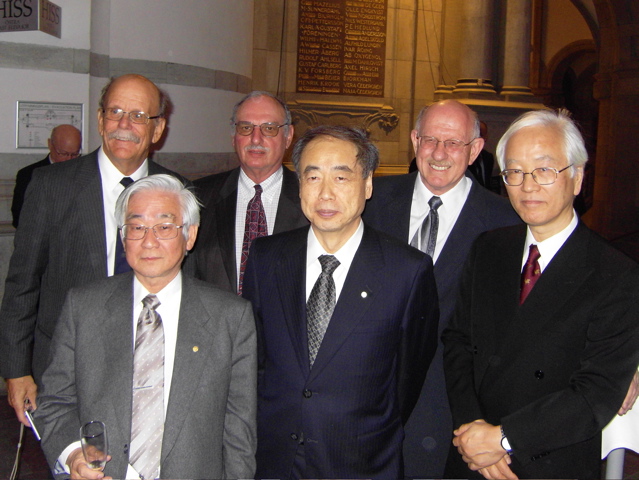
On October 5th, 2015, the American Physical Society awarded the 2016 W.K.H. Panofsky Prize in Experimental Particle Physics to Drs. Fumihiko Takasaki, Stephen Olsen, Jonathan Dorfan and David Hitlin, for “leadership in the BaBar and Belle experiments, which established the violation of CP symmetry in B meson decay, and furthered our understanding of quark mixing and quantum chromodynamics”.
This is the highest award of the APS for experimental particle physics and recognizes the B factory experiments (Belle at KEK and BaBar at SLAC), which observed large CP violation (matter-antimatter asymmetry) in the B meson sector in 2001, and which provided the experimental confirmation of the Kobayashi-Maskawa hypothesis for the origin of CP violation, which was later recognized by 2008 Nobel Prize in Physics.
The four researchers sharing this award are the “founding fathers of the B-factory experiments”. Drs. Takasaki and Olsen led the Belle experiment at the KEK laboratory in Tsukuba, Japan, while Drs. Dorfan and Hitlin led the BaBar experiment at the SLAC laboratory in Stanford, USA, respectively.
The critical role of the two B factory accelerators in the discovery of CP violation in the B sector was previously recognized by the 2004 APS Wilson Prize for Achievement in the Physics of Particle Accelerators. The 2004 Wilson prize was awarded to Katsunobu Oide of KEK and John Seeman of SLAC for their leading roles in the KEKB and PEP-II machines. These two machines set new world records for luminosities in colliding-beam storage rings and enabled the discoveries at Belle and BaBar.
Background Information
B-factory Experiment
An electron - positron collider experimental facility at which electrons and positrons are accelerated nearly to the speed of light and then collided. These collisions result in large numbers of particles called B mesons, which contain bottom quarks, as well as anti-particles called anti-B mesons, which contain anti-bottom quarks. Since this facility produces large quantities of B and anti-B mesons, we call it a “B-factory”.
Belle Experiment
A B-factory experiment conducted from 1998 to 2010 using KEKB accelerator, a high luminosity electrion - positron colider, at KEK in Tsukuba, Japan. More than 400 physicists and engineers from 15 countries and regions participated (as of 2010). Dr. Takasaki led the project from the very beginning of its proposal and served as one of the first Belle spokespersons with Dr. Olsen.
Currently, an upgrade called Belle II, aiming at further measurements of the difference between matter and anti-matter and a search for new physics, is under construction.
BaBar Experiment
A B-factory experiment conducted from 1998 to 2008 using PEP-II accelerator at SLAC in Stanford, California, US. More than 600 physicists and engineers from 13 countries participated. Dr. Dorfan directed the construction of the PEP-II accelerator and eventually also became the technical coordinator for the BABAR detector while Hitlin was the first BaBar spokesperson.
Related Articles
- University of Hawaii UH Physics Emeritus Professor Stephen Olsen wins Panofsky Prize
- KEK Pioneering BaBar and Belle joint analysis
- KEK 50 years from the Discovery of “CP-violation”